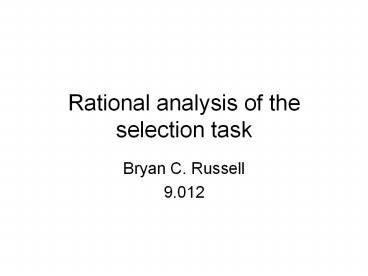Rational analysis of the selection task PowerPoint PPT Presentation
Title: Rational analysis of the selection task
1
Rational analysis of the selection task
- Bryan C. Russell
- 9.012
2
Wason selection task
- Rule if there is an A on one side, then there is
a 2 on the other side
K
2
7
A
3
Another view of the task
- Let rule be if p then q
- Four types of cards
- (p,q), (not-p,q), (p,not-q), (not-p,not-q)
- Two hypotheses
- MD p,q are dependent (rule is true)
- MI p,q are independent (rule is false)
4
Assumptions
- We can assign probabilities to the cards
- Should reflect natural statistics of if p then
q statements in nature - P(p MD) P(p MI) a
- P(q not-p,MD) P(q not-p,MI) b
5
Card probabilities
6
Card probabilities
- Task Select card that maximally reduces
hypothesis uncertainty
7
Entropy/uncertainty
8
Entropy/uncertainty
9
Entropy/uncertainty
10
Another experiment
- Suppose you observe
- TTHTHHTHHHHTHHTHTHHT
11
Another experiment
- Suppose you observe
- TTHTHHTHHHHTHHTHTHHT
- HTHHTTHTHHTTTTTTTTTH
12
Another experiment
- Suppose you observe
- TTHTHHTHHHHTHHTHTHHT
- HTHHTTHTHHTTTTTTTTTH
13
Mutual information
14
Application to selection task
a Pr(p)
15
Application to selection task
a Pr(p)
16
Model behavior
17
Observations
- If Pr(q) is low, then choosing p card is
informative - If Pr(p) and Pr(q) is low, then choosing q card
is informative - If Pr(p) is high, then choosing not-q card is
informative - not-p card is not informative (results in zero
information) - P(MI) only scales information values
18
Model behavior
R
19
Rarity assumption
- For selection task, in humans Pr(p) and Pr(q) are
low - Expected information over region R
- choose p 0.76
- choose q 0.20
- choose not-q 0.09
- choose not-p 0
20
How do humans compare?
21
(No Transcript)
22
(No Transcript)
23
Analysis
- Both humans and model accounts for the following
information relationship - choose p gt choose q gt choose not-q gt choose not-p
24
Thematic selection task
25
Utility-based model
26
Validity of the rarity assumption
27
Discussion questions
- Why use a probabilistic framework for
rationality? - Is the selection task representative of
accounting for rational thought? Is it
exhaustive?
PowerShow.com is a leading presentation sharing website. It has millions of presentations already uploaded and available with 1,000s more being uploaded by its users every day. Whatever your area of interest, here you’ll be able to find and view presentations you’ll love and possibly download. And, best of all, it is completely free and easy to use.
You might even have a presentation you’d like to share with others. If so, just upload it to PowerShow.com. We’ll convert it to an HTML5 slideshow that includes all the media types you’ve already added: audio, video, music, pictures, animations and transition effects. Then you can share it with your target audience as well as PowerShow.com’s millions of monthly visitors. And, again, it’s all free.
About the Developers
PowerShow.com is brought to you by CrystalGraphics, the award-winning developer and market-leading publisher of rich-media enhancement products for presentations. Our product offerings include millions of PowerPoint templates, diagrams, animated 3D characters and more.

